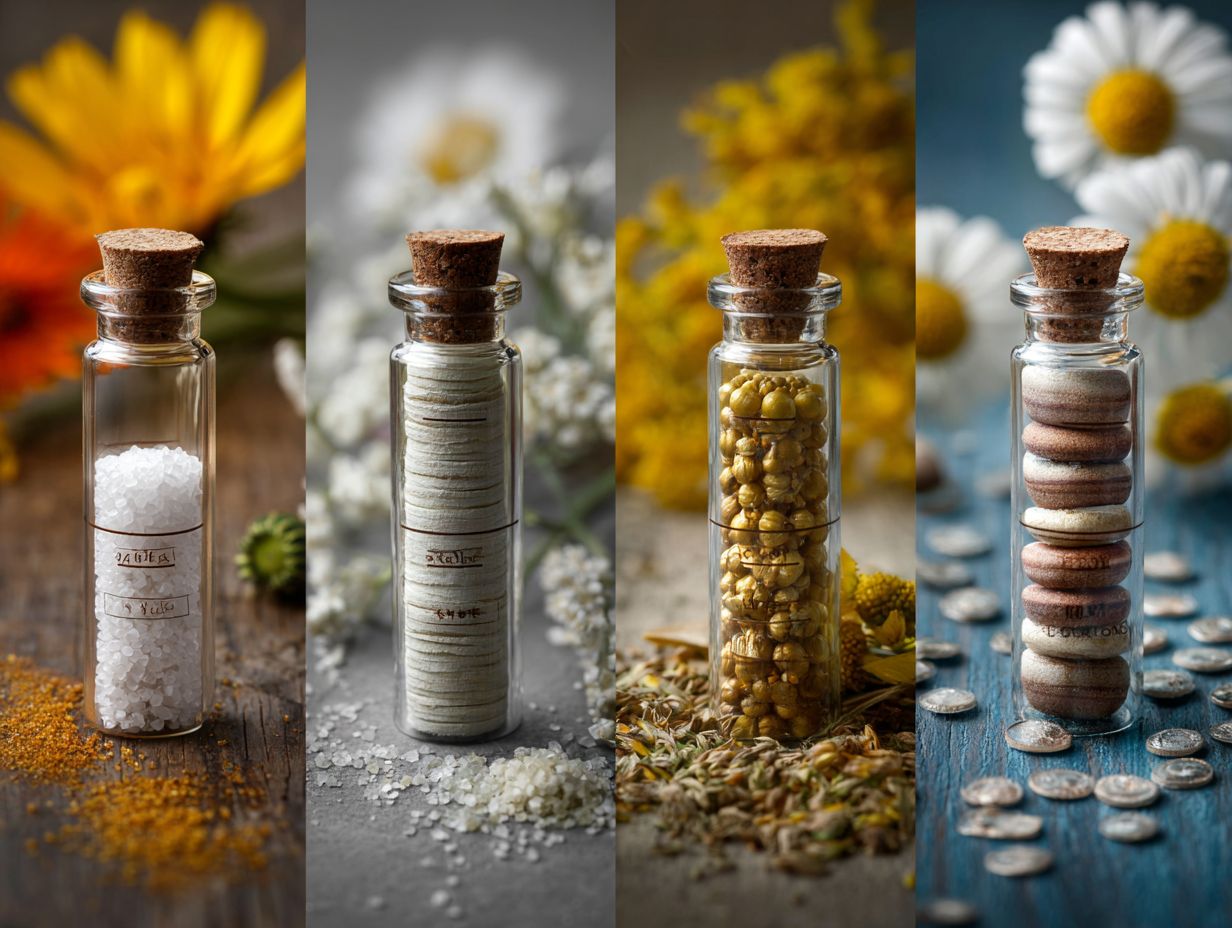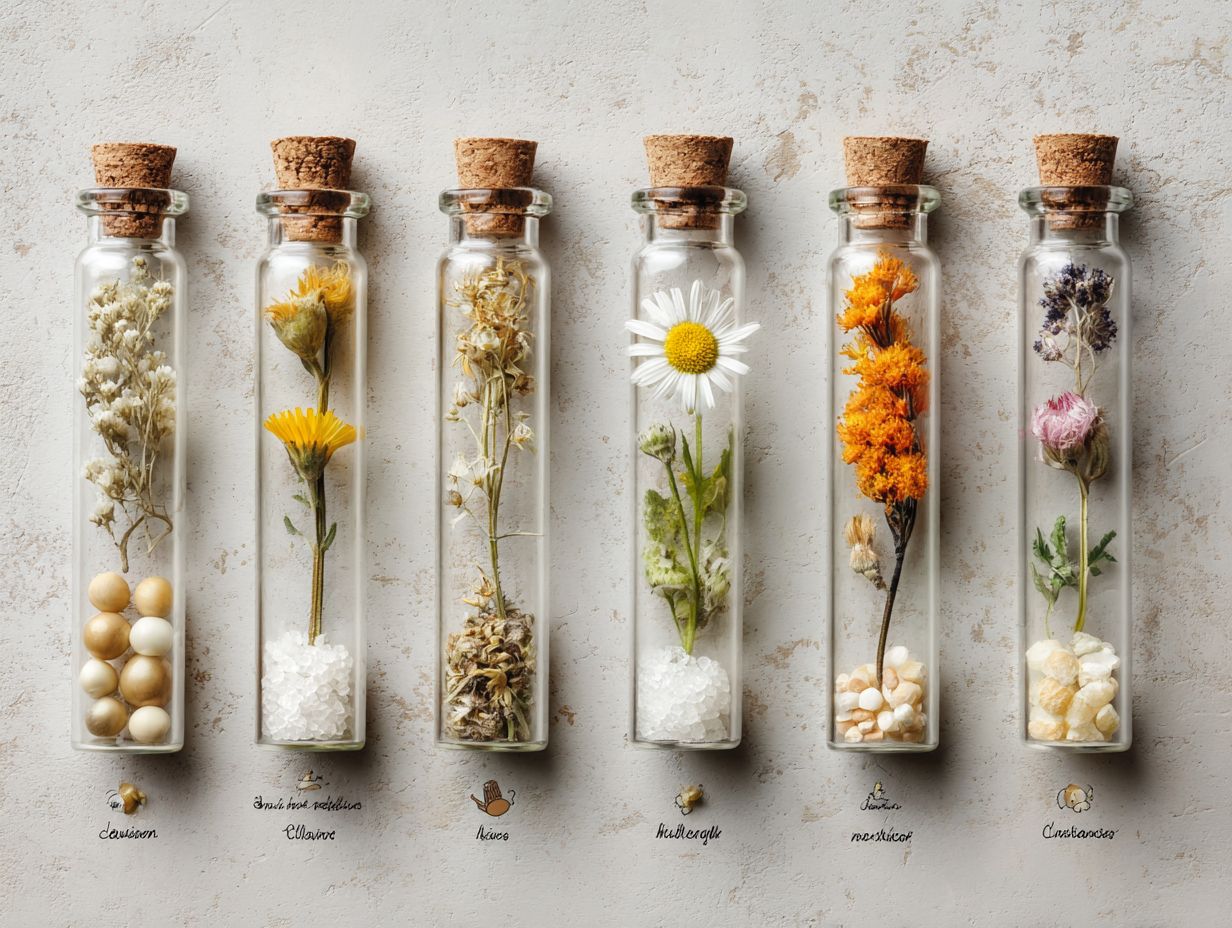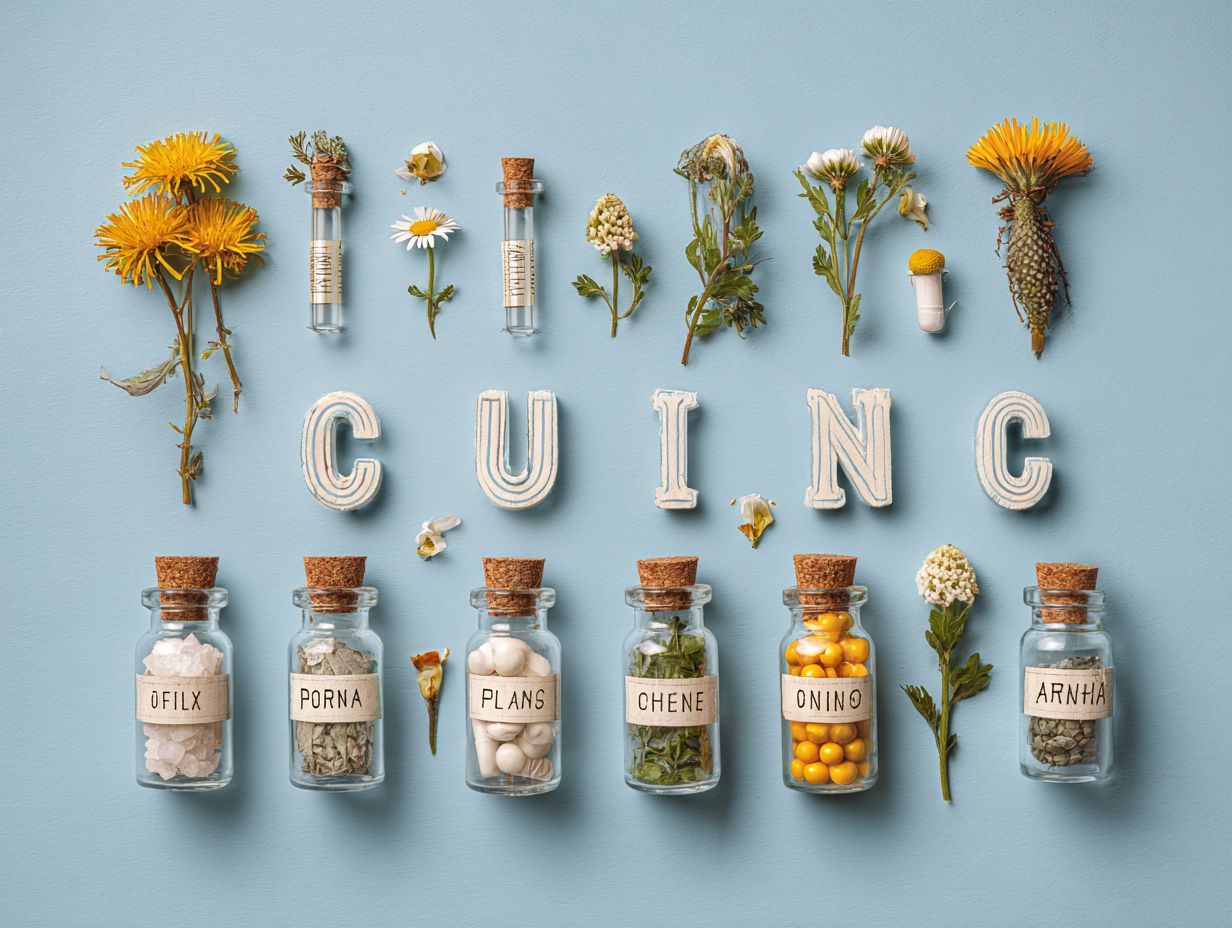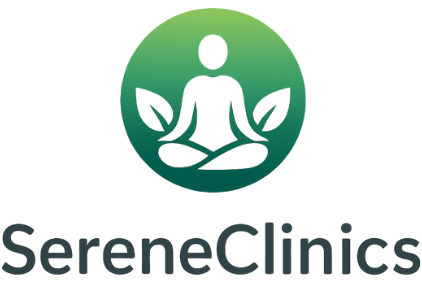Like Cures Like in Homeopathy: Examples
Homeopathy operates on the fascinating principle of “like cures like,” a concept pioneered by Samuel Hahnemann. This law of healing suggests that substances causing symptoms in healthy individuals can treat similar symptoms in the sick. Digitalis can cause heart problems, but it is used in homeopathy to address heart conditions. In this article, we will examine the basics of this principle, providing clear examples that show its importance in current practice.
Key Takeaways:
Contents
- 1 Historical Background
- 2 Mechanisms of Action
- 3 Examples of ‘Like Cures Like’
- 4 Clinical Evidence and Studies
- 5 Homeopathy Success Rates: Long-term Observational Study
- 6 Practical Applications
- 7 Frequently Asked Questions
- 7.1 What is the principle of “like cures like” in homeopathy?
- 7.2 Can you provide an example of “like cures like” in homeopathy?
- 7.3 How is the substance diluted in homeopathic remedies?
- 7.4 What is the scientific basis for “like cures like” in homeopathy?
- 7.5 Are there any potential risks or side effects associated with using “like cures like” in homeopathy?
- 7.6 Why is “like cures like” considered a key principle in homeopathy?
Definition of Homeopathy

Homeopathy, founded by Samuel Hahnemann, defines a therapeutic approach where highly diluted substances are believed to trigger the body’s innate healing responses. According to a comprehensive overview from Britannica, homeopathy’s history and principles have evolved significantly over the years.
Central to homeopathy are the principles of `like cures like’ and the law of infinitesimals, where a substance that causes symptoms in a healthy person can treat similar symptoms in a sick person.
Treatment is highly individualized; for example, two patients with the same diagnosis may receive different remedies based on their unique symptoms and lifestyle.
Practitioners often use tools like the Remedy Finder app or homeopathy books to carefully check symptoms and provide specific treatment plans that support overall health. For an extensive analysis of holistic approaches, explore our deep dive into Traditional Chinese Medicine.
Principle of ‘Like Cures Like’
‘Like cures like’ is a core tenet of homeopathy, suggesting that a substance causing symptoms in a healthy person can be used to treat similar symptoms in a sick person.
In the 18th century, Samuel Hahnemann used substances like cinchona bark, which causes fever, to treat malaria.
In modern applications, a common example is the use of Allium cepa (onion), which can induce symptoms similar to colds and allergies, to alleviate similar conditions in patients.
This opposite effect, focusing on the body’s natural reactions, is a debated and interesting part of homeopathic methods. Research published in Wikipedia provides a comprehensive overview of the evidence and efficacy surrounding these practices.
Historical Background
The history of homeopathy goes back to the 18th century when Samuel Hahnemann established its principles as an alternative to the shortcomings of conventional medicine. Interested in how these principles are applied today? Learn more about the practices and evidence-based integration of homeopathy.
Samuel Hahnemann’s Contributions
Samuel Hahnemann, the pioneer of homeopathy, introduced the concept of potentization and established the foundational texts that guide homeopathic practice today.
His main works, especially the “Organon of Medicine,” clearly explain the ideas behind homeopathy, focusing on the concept of treating illnesses with substances that cause similar symptoms.
Hahnemann also created new treatments, often using natural substances, which were diluted and shaken to increase their healing effects-a process called potentization.
He introduced the concept of individualized treatment, encouraging practitioners to tailor remedies based on a patient’s unique symptoms rather than just the illness itself.
This complete method changed medical treatment in the 18th century and still affects doctors today.
Evolution of Homeopathic Practices
Since Hahnemann’s time, homeopathy has changed, fitting in with modern medical practices while keeping its core ideas and beliefs.
Lately, homeopathy has used modern research methods more frequently to prove it works. Notably, studies on the micro-dilution processes have emerged, highlighting potential mechanisms behind treatment effects.
Regulations have become stricter, with countries such as Germany demanding tougher safety and quality checks for homeopathic products. The development of new remedies often relies on sophisticated technological advancements such as nanotechnology, enhancing both effectiveness and patient acceptability. According to the Federal Register, these stricter measures are part of broader efforts to evaluate and adapt regulatory frameworks for homeopathic products, ensuring they meet modern safety standards (Federal Register).
These changes show an ongoing attempt to connect traditional homeopathic methods with modern scientific knowledge.
Mechanisms of Action
Learning how homeopathy works shows how substances, even when very diluted, interact with the body’s ability to heal itself. This approach is deeply connected to the Law of Minimum Dose in homeopathy, which underscores the effectiveness of minimal concentrations.
Learning About Dilution and Potentization
The processes of dilution and potentization involve repeatedly mixing a substance with a liquid and shaking it, which is thought to make its healing effects stronger while lowering harmful side effects.
In homeopathy, dilution typically follows a ratio of 1:10 (for decimal potencies, denoted as ‘X’) or 1:100 (for centesimal potencies, denoted as ‘C’).
For example, a 30C potency indicates a substance has been diluted to one part per 100 30 times.
Potentization is a process where the liquid is shaken strongly between each dilution step. Supporters believe this process imparts the material’s ‘energy’ to the water. This method emphasizes safety, as it significantly reduces toxicity.
Learning about these processes can help with treatment decisions, particularly for long-term health problems where traditional medicine may not be enough.
Concept of Vital Force
Homeopathy suggests that there is an energy within people that controls health, and treatments focus on bringing this energy back into balance.
This essential energy is thought to control the body’s physical functions, allowing for natural recovery. Stress or illness can often cause symptoms of disease to appear.
Homeopathic treatments use substances in very small amounts to activate the body’s natural energy, helping it fix imbalances. Arsenicum album is commonly used to help with anxiety and stomach issues, relying on the body’s own healing processes.
The main goal is to trigger the body’s natural balance, supporting overall health through gentle adjustments.
Examples of ‘Like Cures Like’

Real-life cases of ‘like cures like’ show how homeopathic treatments are used to manage different health issues. If interested, you might explore the principles and practices of homeopathy to understand its evidence-based integration.
Arsenicum Album for Food Poisoning
Arsenicum Album is a well-known homeopathic remedy for food poisoning, addressing symptoms such as nausea and diarrhea by mirroring the toxic effects of arsenic at low doses.
To use Arsenicum Album correctly, talk to a homeopathic expert for dosage advice specific to your situation. A 30C dose can be administered every 15-30 minutes when symptoms are severe, then reduce frequency as symptoms improve.
Users often report relief within a few hours, particularly as it can help alleviate the anxious feelings associated with food poisoning. Remember that although many people find it helpful, results can differ. Keep track of your symptoms, and contact a professional if they don’t improve.
Allium Cepa for Allergic Rhinitis
Allium Cepa, derived from onions, is effective in treating allergic rhinitis, alleviating symptoms like sneezing and runny nose by mimicking the irritant effects of onions.
To prepare Allium Cepa for allergic rhinitis, consider using homeopathic pellets available at health stores, typically in 30C potency.
Adults should take 5 pellets three times daily. Children should take 3 pellets three times daily. This natural remedy minimizes side effects, although some may experience mild digestive upset.
Recent studies indicate that it can significantly reduce nasal congestion and improve overall comfort for individuals suffering from seasonal allergies. Always consult a healthcare professional before starting any new treatment regimen.
Belladonna for Fever
Belladonna is used in homeopathy to help with fever, especially when symptoms include redness and warmth, which resemble the symptoms it causes in large amounts.
In homeopathy, belladonna is a remedy for high fevers when someone has a flushed face, a strong pulse, and is sensitive to light.
A common dose is 30C every 2-3 hours during sudden episodes, and it can be given less often as symptoms improve. This approach embodies the principle of ‘like cures like,’ where substances causing similar symptoms in healthy individuals are used to treat those same symptoms in the sick.
Patients should talk to a knowledgeable homeopath to get treatment plans made just for them.
Nux Vomica for Hangovers
Nux Vomica is a popular homeopathic remedy for hangovers, targeting symptoms like nausea and headache by reflecting the effects of overindulgence.
To prepare Nux Vomica, dissolve 30C pellets under your tongue either before drinking or at the onset of hangover symptoms.
Take 3 to 5 pellets every few hours, depending on how bad the symptoms are.
Many users report feeling better quickly; for instance, one person said that after trying Nux Vomica, their nausea decreased, allowing them to get back to their usual activities.
Remember, this remedy is most effective when combined with drinking enough water and getting enough rest, which helps with hangover recovery.
Apis Mellifica for Insect Stings
Apis Mellifica is specifically indicated for insect stings, effectively reducing swelling and pain by mimicking the effects of a bee sting.
- For best results, take 30C strength. Dissolve five pellets under your tongue every 15 minutes for a total of four times. Then, use less often as your symptoms improve.
Before applying, make sure the area is clean and dry to help it soak in well.
Evidence from various studies highlights Apis Mellifica’s efficacy in alleviating symptoms associated with bee and wasp stings, showing improvement in both pain levels and swelling within a few hours of dosing.
Always speak with a healthcare professional for personal guidance.
Phosphorus for Respiratory Issues
Phosphorus is used in homeopathy for treating breathing problems, helping with issues like cough and trouble breathing, by imitating the irritating qualities of phosphorus.
Preparations are available in strengths such as 6X, 30C, or 200C, depending on how serious the symptoms are.
For adults, a common dosage might be 5 pellets of 30C taken three times daily. Speak with a healthcare provider for personalized advice.
Patients often report significant relief, especially when combined with rest and hydration, as phosphorus works by alleviating inflammation in the respiratory tract and facilitating easier breathing.
Regular follow-ups can improve the treatment plan.
Clinical Evidence and Studies
Looking at clinical evidence and studies helps clarify how effective homeopathy is, amid ongoing debates about its scientific validity. The integration of homeopathy into modern medicine, as outlined in principles and practices, provides a broader understanding of its potential effectiveness.
Homeopathy Success Rates: Long-term Observational Study
Homeopathy Success Rates: Long-term Observational Study

Treatment Success: Severity Reduction Over 8 Years
Treatment Success Rates: Quality of Life Improvement
Treatment Success Rates: Satisfaction and Recommendation
The Homeopathy Success Rates: Long-term Observational Study provides information about how effective homeopathic treatments are and how people view them over a long time. The data shows improvements in symptom severity, quality of life, and patient satisfaction among different age groups, offering important information about homeopathy’s effects.
Treatment Success Rates show large decreases in symptom severity in both adults and children. For adults, initial severity decreased from 6.2 to 2.9 at two years and further declined slightly to 2.7 at eight years. This suggests sustained effectiveness over multiple years. For children, severity scores dropped from 2.1 at two years to 1.7 at eight years, indicating even greater improvement and perhaps a better response to homeopathic treatment in younger individuals.
Quality of Life Improvement data reflect positive changes, with adults reporting improvements in both physical (score 0.39 ) and mental quality of life (score 0.54 ). These measurements indicate that homeopathic treatments may help improve overall health, benefiting both body and mind.
- Satisfaction and Recommendation: The study reveals high levels of satisfaction among both adults and children, with 38.4% of adults and 41.8% of children expressing being “very satisfied” with their treatment. Furthermore, 87.4% of patients recommend homeopathy, indicating widespread approval and perceived effectiveness. Notably, 67.4% of patients choose homeopathy again, underscoring a strong loyalty and trust in its therapeutic benefits.
The Homeopathy Success Rates data suggest that homeopathy may offer effective long-term relief and improve the quality of life for many patients, particularly children. High satisfaction rates and recommendations further highlight its acceptance and potential as a preferred treatment option. This study gives a complete look at the long-term benefits of homeopathy and supports more research into how it works and its wider use in healthcare.
Research Supporting Homeopathy
Research on homeopathy includes detailed studies indicating it may work for different health issues, though more detailed studies are needed.
One significant finding indicates that homeopathy may alleviate symptoms of conditions such as allergic rhinitis and osteoarthritis. For example, a meta-analysis published in a reputable journal highlighted that patients receiving homeopathic treatments experienced better symptom relief compared to placebo groups.
Homeopathic doctors often create treatment plans based on individual assessments, which makes patients more engaged and satisfied with their care. Clinicians may consider incorporating homeopathy as a complementary approach, particularly for chronic conditions where conventional treatments have limited success, always emphasizing informed consent and patient education.
Criticism and Controversies
Criticism of homeopathy often centers around its perceived lack of scientific grounding and efficacy, leading to ongoing controversies in the medical community.
Critics argue that homeopathy is based on concepts that contradict established scientific principles, such as the notion that diluting substances increases their healing power. They frequently mention thorough reviews showing no meaningful difference between homeopathic treatments and placebo.
Proponents counter that individual case studies and anecdotal evidence illustrate benefits, suggesting that personal experiences may not always align with empirical data. This ongoing debate highlights the broader discussion about complete-person versus traditional treatments, showing the need for more detailed and careful research.
Practical Applications
Practical uses of homeopathy help patients in selecting the right treatment and finding experienced homeopaths for personalized care.
Choosing the Right Remedy
Picking the correct homeopathic treatment needs knowledge of personal symptoms and health issues to make sure the treatment works well.
- Start by closely observing symptoms and identifying patterns. For example, note the intensity of pain, emotional state, and any triggers.
- This detailed observation can guide you in matching remedies, such as Arnica for bruises or Nux Vomica for digestive upset.
- Consider using tools like the ‘Homeopathic Materia Medica’ to research remedies. Consult with experienced practitioners through platforms like the National Center for Homeopathy to validate your selections and tailor treatments to your specific needs.
Remember, individualization is key in homeopathy.
Consulting a Homeopath

Visiting an experienced homeopath is important to get the right treatment and make sure the remedies fit your personal health needs and conditions.
To start, find a licensed homeopath using trusted directories or nearby health clinics. During the first meeting, be ready to share a complete health history. This should cover past illnesses, medications, and emotional health.
This thorough assessment allows the homeopath to understand your unique constitution and symptoms deeply. Expect the consultation to last about 60-90 minutes, with plenty of time for questions and discussions about your lifestyle.
After this, the homeopath will recommend a treatment plan made just for you, often including remedies to help with your recovery.
Future of Homeopathy
Many healthcare providers and patients see benefits in using homeopathy together with traditional treatments, and its outlook is encouraging.
This trend creates many research opportunities, especially in clinical trials that test the effectiveness of homeopathic treatments against regular medical therapies.
Collaboration between homeopaths and conventional medical institutions can contribute to a more integrated healthcare approach, enhancing acceptance. Regulations are changing, focusing more on the safety and consistency of homeopathic products.
As more people become informed, teaching about homeopathy might become common in medical education, promoting broader knowledge among healthcare professionals.
Final Thoughts on ‘Like Cures Like’
Final reflections on the principle of ‘like cures like’ highlight its significance in the philosophy and practice of homeopathy.
This principle asserts that a substance causing symptoms in a healthy person can be used to treat similar symptoms in a sick person.
Practitioners use treatments made for each individual, like giving Arsenicum album to help with anxiety when physical symptoms such as tremors or restlessness are present.
Software tools are extremely helpful for examining symptoms and identifying the right solutions quickly.
By bringing this idea together with current tools, practitioners can create treatment plans that match each person’s needs, making them suitable and effective for homeopathic practice today.
Frequently Asked Questions
What is the principle of “like cures like” in homeopathy?
The concept of “like cures like” is based on the belief that a substance that can cause symptoms in a healthy person can also cure those same symptoms in a sick person when given in a highly diluted form.
Can you provide an example of “like cures like” in homeopathy?
One example is the use of Allium cepa, or red onion, to treat symptoms of the common cold such as watery eyes and a runny nose. These are also symptoms that can be caused by exposure to raw onions.
How is the substance diluted in homeopathic remedies?
Homeopathic remedies are usually made by a method called “potentization.” This involves mixing the original substance with water or alcohol, then shaking the mixture strongly.
What is the scientific basis for “like cures like” in homeopathy?
The principle of “like cures like” is not widely accepted in conventional medicine and is not supported by scientific evidence. However, homeopathy is grounded in the belief that even when a substance is diluted, it keeps its energy or vibrations, which can trigger the body’s ability to heal itself.
Are there any potential risks or side effects associated with using “like cures like” in homeopathy?
Since homeopathic remedies are highly diluted, they are generally considered safe and have few known side effects. However, people should always talk to a certified healthcare provider before using any homeopathic treatments.
Why is “like cures like” considered a key principle in homeopathy?
In homeopathy, the goal is to treat the individual as a whole and not just the specific symptoms or disease. The idea that “like cures like” means tailoring treatment to each person’s specific symptoms and traits.

Sheetal Sharda has a background in CS. She got an interest in Holistic living back in 2018, and has since started exploring more into Naturapathy, Holistic Living, Yoga, and more. She got inspired to start SereneClinics to help people find reliable centers across the world.




